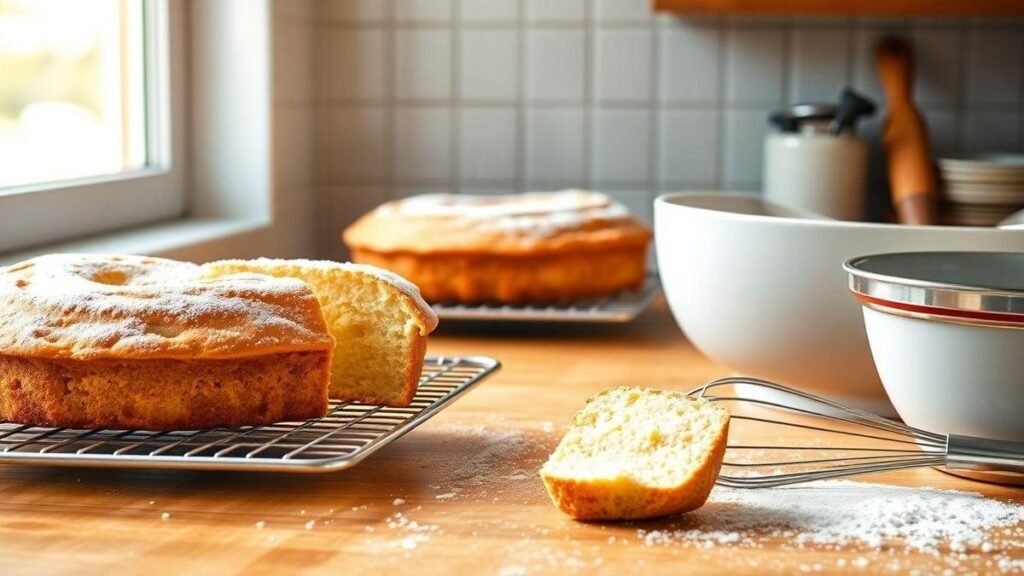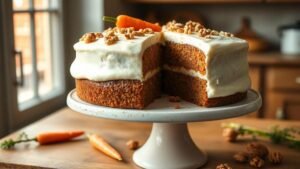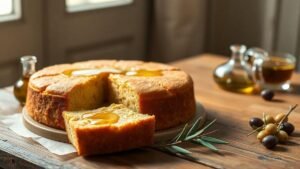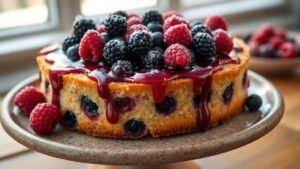I understand the frustration of wanting a soft cake without a mixer. You can make a light, fluffy, super-soft cake using just a whisk, a fork, and a bowl. Below is a reliable, SEO-friendly recipe — Super-Soft Oil-Based Vanilla Cake (No Mixer) — plus clear tips for hand-mixing, add-ins, no-mixer toppings, and storage. Learn why mixer-free baking works and which ingredients and gentle techniques create a tender crumb.
Quick wins:
- Make a soft, fluffy cake by hand — no electric mixer needed
- Use simple tools: whisk, fork, bowl, spatula
- Try the oil-based vanilla cake recipe for lasting tenderness
- Mix gently and use the right ingredients for a tender crumb
- Easy add-ins, no-mixer toppings, and simple storage tips
How to Make a Soft Cake Without a Mixer: Simple Tools, Fluffy Results
I love the quiet of hand-baking. With a few basic tools — a whisk or fork, a bowl, and patience — you can get a soft, fluffy, and moist cake. Below I explain the why, how, a dependable recipe, and practical tips to make hand-mixing enjoyable and effective.
Quick facts
| Tools needed | Big idea | Result |
|---|---|---|
| Whisk, fork, bowl, spatula | Gentle mixing = soft crumb | Super-soft cake without a machine |
Why Go Mixer-Free?
I sometimes skip the mixer for quiet mornings. Benefits:
- Less cleanup — a whisk is easy to wash
- Gentle texture — hand-mixing preserves a tender crumb
- Lower cost — basic tools suffice
- Portable — bake anywhere, even in a small kitchen
Sometimes limits spark better results — and many of the same principles are covered in guides about secrets to making fluffy, soft cakes that work without heavy equipment.
What Makes a Cake Soft Without a Mixer?
Softness comes from the right ingredients and gentle technique. Key factors:
| Factor | How it helps |
|---|---|
| Oil (vs. butter) | Keeps the crumb moist and tender |
| Cake flour | Lower protein; finer crumb |
| Buttermilk or milk | Adds tenderness and flavor |
| Eggs (whisked by hand) | Provide lift and structure |
| Gentle folding | Keeps air pockets intact for fluff |
If you want a quick comparison of fat choices and structure, see a simple explanation of sponge cakes versus butter cakes.
Tip: Bring ingredients to room temperature (15–30 minutes) so they mix more smoothly.
Super-Soft Oil-Based Vanilla Cake (No Mixer)
This oil-based cake stays tender for days — a perfect beginner-friendly no-mixer recipe.
Ingredients
- Dry:
- 2 cups cake flour (or 1 3/4 cups all-purpose 1/4 cup cornstarch)
- 1 1/2 cups sugar
- 1 tbsp baking powder
- 1/4 tsp baking soda
- 1/2 tsp salt
- Wet:
- 1 cup vegetable oil
- 2 large eggs, room temperature
- 1 cup buttermilk (or milk 1 tbsp lemon juice)
- 2 tsp vanilla extract
If you prefer to swap oil for a lighter, fruit-based option, see tips for using applesauce instead of oil or butter.
Tools
- Whisk — mix batter, whip eggs (see notes on hand-whisking in my hand-whisked layer cake experience)
- Fork — alternative for small batches (more on minimal tools in how to make a cake using only a fork and a bowl)
- Two bowls — one for dry, one for wet
- Spatula — fold and scrape
- 8- or 9-inch pan
Instructions (step-by-step)
- Preheat oven to 350°F (175°C). Grease the pan lightly.
- Whisk dry ingredients together until blended.
- In another bowl, whisk oil and sugar until smooth. Add eggs one at a time, whisking ~20–30 seconds after each.
- Stir in vanilla.
- Add dry and buttermilk in 3 batches: dry, then wet, then dry. Fold gently with a spatula or whisk. Stop when batter is smooth — do not overmix.
- Pour into pan and tap the pan on the counter twice to release large air bubbles.
- Bake 25–30 minutes, or until a toothpick comes out clean.
- Cool 10 minutes in pan, then transfer to a wire rack.
A calm, steady pace helps you spot when the batter is ready. If you’re exploring other no-mixer leavening approaches, this guide about making cakes without baking powder offers useful context.
Tips for Mixer-Free Baking
| Tip | Why it helps |
|---|---|
| Warm eggs and milk | Mix easier; smoother batter |
| Whisk eggs first | Adds air and lift |
| Fold, don’t beat | Preserves lightness |
| Use oil for moistness | Oil stays liquid at room temp for softer cake |
| Sift dry ingredients | Removes lumps and aerates flour |
| Tap pan to remove large bubbles | Creates even texture |
For extra technique guidance on trapping air and keeping cakes tender by hand, these fluffy cake tips are handy. Avoid overmixing — it’s the most common cause of dense cakes.
Easy Add-Ins and Flavor Ideas
Add-ins mix in by hand and don’t need a mixer:
| Add-in | Amount | Tip |
|---|---|---|
| Chocolate chips | 3/4 cup | Toss with a little flour to prevent sinking — inspired by ideas in fluffy chocolate cake techniques |
| Lemon zest | 1–2 tsp | Fresh zest brightens flavor |
| Mashed banana | 1/2 cup | Reduce sugar slightly |
| Cocoa powder | 1/4 cup (swap some flour) | Stir gently |
| Chopped apples | 1 cup | Toss with cinnamon |
| Dates honey | 3/4 cup dates, 2 tbsp honey | Soak dates if dry — also check my notes on naturally sweetened cakes for inspiration |
Safety note: avoid tasting raw batter with raw eggs. Use pasteurized eggs or taste frosting instead.
If you want to experiment with flour alternatives, see guides for cakes made with whole-wheat flour, oat flour, or gluten-free blends.
Toppings That Need No Mixer
Finish the cake without a mixer:
| Topping | How to make |
|---|---|
| Simple glaze | Mix powdered sugar milk until pourable; drizzle |
| Whipped cream (no mixer) | Chill bowl and whisk; whip by hand ~5–8 minutes |
| Yogurt frosting | Mix Greek yogurt honey vanilla and spread cold — similar ideas in yogurt-based cake recipes |
| Melted chocolate | Melt chips with a little butter, pour and spread |
| Fresh fruit | Arrange berries; brush with warmed jam for shine |
I often use a simple glaze — fast, pretty, and delicious. For cakes that shine without heavy frosting, see ideas for no-frosting cakes.
Storage
Keep your cake soft with these methods:
| Method | Time | Tip |
|---|---|---|
| Room temp, covered | Up to 2 days | Wrap in foil or use an airtight carrier |
| Fridge | 4–5 days | Bring to room temp before serving |
| Freezer (slices) | 1–2 months | Wrap slices well; thaw overnight in fridge |
Label frozen items with the date to avoid guesswork.
Do’s and Don’ts (Pocket Guide)
| Do | Don’t |
|---|---|
| Use oil for moistness | Overmix batter |
| Warm ingredients | Rush the folding |
| Whisk eggs lightly | Use cold eggs straight from the fridge |
| Tap the pan | Skimp on baking time |
Comment & Reply
Your email address will not be published. Required fields are marked.
| Form field | Input |
|---|---|
| Comment | [textarea] |
| Name | [input] |
| [input] | |
| Website | [input] |
| Save my details for next time | [checkbox] |
Last Posts
| Post title | Short note |
|---|---|
| I Bake Nut-Free Cakes for Kids | Nut-free swaps and tips |
| I Bake Cakes With Dates And Honey | Natural sweetener ideas |
| I Bake Cake With Just A Fork | Small tools, big results |
| I Ditch Nuts For Ultimate Carrot Cake | How I keep carrot cake safe for kids |
Conclusion
If you want a soft, fluffy cake but no mixer is available, this is a simple truth: with a whisk or fork, the right ingredients (oil, cake flour, warm eggs, buttermilk), and gentle folding, you can achieve bakery-worthy results. Whisk eggs for lift, fold to preserve air, and tap the pan to release big bubbles. Add-ins and no-mixer toppings are the finishing touch, and smart storage keeps the cake soft for days. This method isn’t a compromise — it’s a craft. Try it and enjoy the comfort of hand-baked cake.
If you enjoyed this, read more recipes and tips at https://xendrie.com — I’m saving the next helpful secret for you.
Frequently Asked Questions
Q: Do I need an electric mixer to bake fluffy cakes by hand?
A: No. A whisk, fork, bowl, and elbow grease do the job. Good technique beats gadgets. See practical steps in this guide to mixer-free cakes.
Q: What makes a cake soft without a mixer?
A: Whisked eggs, oil for moisture, sifted flour, and gentle folding. Air fat = soft crumb.
Q: How do I whisk eggs by hand to get fluff?
A: Whisk vigorously in a wide bowl until pale and slightly thickened — about 2–4 minutes. Read about my experience in whisking a layer cake by hand.
Q: Can I really use a fork instead of a whisk?
A: Yes. A fork works for small batches. Move fast in big circles to trap air — or follow the approach in making a cake with only a fork and a bowl.
Q: How do I store a hand-mixed cake to keep it fluffy?
A: Keep it airtight at room temperature up to 2 days; refrigerate for longer and bring to room temp before serving.






